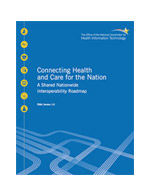 ONC accepted public comments on Connecting Health and Care for the Nation: A Shared Nationwide Interoperability Roadmap Draft Version 1.0. The comment period ended on April 3, 2015.
ONC accepted public comments on Connecting Health and Care for the Nation: A Shared Nationwide Interoperability Roadmap Draft Version 1.0. The comment period ended on April 3, 2015.
The draft Roadmap proposes critical actions that need to be taken by both private and public stakeholders to advance the nation towards a more connected, interoperable health IT infrastructure and was drafted by ONC based on input from private and public stakeholders. The draft Roadmap outlines the critical actions for different stakeholder groups necessary to help achieve an interoperable health IT ecosystem.



Interoperability Comments
Commonwealth of Pennsylvania - Justice Network
See attached document for full set of comments.
justice_practitioner_response_to_onc_roadmap_v_1.0_4-2_2015.docxMy opposition to a national tracking system is primarily two-fold:
1) What a tremendous loss of freedom! My health information should be mine to share with parties only of my choice. This type of system would be an egregious affront not only to doctors, but also to every citizen.
2) We, as a nation, are already broke. Do we really have to spend a ridiculous amount of money (we already know this will cost SO much to implement) taking away freedom?
Thanks much for hearing my deep concerns!
I oppose the creation of a national medical records system that tracks patients and controls doctors without their consent.
We must ensure that patients can maintain privacy.
This system would be vulnerable to hacking.
States rights must not be undone.
Open Source Electronic Health Record Alliance (OSEHRA)
The Open Source Electronic Health Record Alliance (OSEHRA) would like to point out the advantages that can accrue from the adoption and extension of open source solutions to address the issues in the Roadmap. In particular, deployments of open source versions of the VistA EHR not only enable data aggregation but also provide frameworks for interoperability at low cost. Such capabilities can be seen in OSEHRA's ViViAN(tm) visualization tool at code.OSEHRA.org/ViViAN, which illustrates how open source VistA allows interoperability via HL7, remote procedure calls, and web services. Current VistA prototypes and development efforts, underwritten by interested public-sector and private-sector organizations such as ONC and supported by an aware and enthusiastic community, can make HL7 FHIR and similar RESTful standards available in a short time at low cost.
These standards, in turn, can enable "quick wins" in areas including real-time results visualizations such as those being developed by the Health Services Platform Consortium (HSPC) and being prototyped in current projects at the Veterans Health Administration (VHA). We believe that it is essential to focus on such closely targeted, properly resourced efforts to produce the highly visible results needed to achieve buy-in to the longer-term objectives in ONC's roadmap. Such successes will lay the groundwork for improved health data availability and better decision making and outcomes over the next decade.
We encourage ONC to concentrate in the short term on a narrow, highly visible scope with high potential for success, while maintaining a long-term focus on the many infrastructural needs cited in the Roadmap.
Home Care Technology Association of America
Supplemental PowerPoint Presentation referenced in (HCTAA) comments.
adopting_information_technologies_for_post-acute_and_long-term_care_presentation_before_onc_and_institute_for_ehealth_policy.pdfGreenway Health
Please see attached comment in full, organized by section.
greenway_comment_onc_interoperability_roadmap_4.2.15.pdfLakeland Baptist Church
Proposes to repeal federal law that allows state legislatures to enact true medical privacy laws for citizens. The Roadmap proposes to undo state’s rights under HIPAA to enact state laws and conform all state laws to federal HIPAA “no privacy” rule. (p. 67) Therefore, I oppose it!
Views patient data as public property rather than personal property: “Data holders … should ensure standards are prioritized, developed and implemented to support the public interest, national priorities and the rights of individuals.” (p. 33) This is a bad idea!
Makes patients vulnerable to hacking of patient data: “As health IT systems have become increasingly connected to each other, cyber threats have concurrently increased at a significant rate. In an interoperable, interconnected health system, an intrusion in one system could allow intrusions in multiple other systems.” (p. 55)The risks are too great!
Privacy of personal medical information is a big concern and should be kept only within the confines of the doctor's records. These records should only be shared with explicit consent of the patient.
Patient data is NOT public property. It is private property of the doctor/patient relationship. Only when the patient requests the data to be shared for treatment or research purposes should the data then be shared.
A national health database is dangerous. Even with good responsible healthcare entities, the country has experienced the theft of data by cyber attack (hackers). Placing everyone's data in one place is only asking for trouble.
Requiring doctors to submit to a national database repository to get paid is blackmail. Piling on more administrative requirements to a doctors office does not result in better care, only more costs that someone (doctor or patient) will incur.
Virtua Health
In response to the section "Questions on the Roadmap", Number 2, Priority Use Cases, Please submit 3 priority use cases from this list that should inform priorities for the development of technical standards, policies and implementation specifications.
We requested feedback from our physicians that make up the Virtua HIE Physician Usage Committee. The following 3 use cases from Appendix H were identified as the priorities:
11. Narrative components of the medical record are preserved for provider and patient use and augmented with metadata to enable effective storage, routing and searching for these documents.
33. Providers have the ability to query data from other sources in support of care coordination (patient generated, other providers, etc.) regardless of geography or what network it resides in
41. Providers and patients receive electronic laboratory results from laboratory information systems (LISs) inside and outside their organization
American Nurses Association
Please see the American Nurses Association's uploaded document.